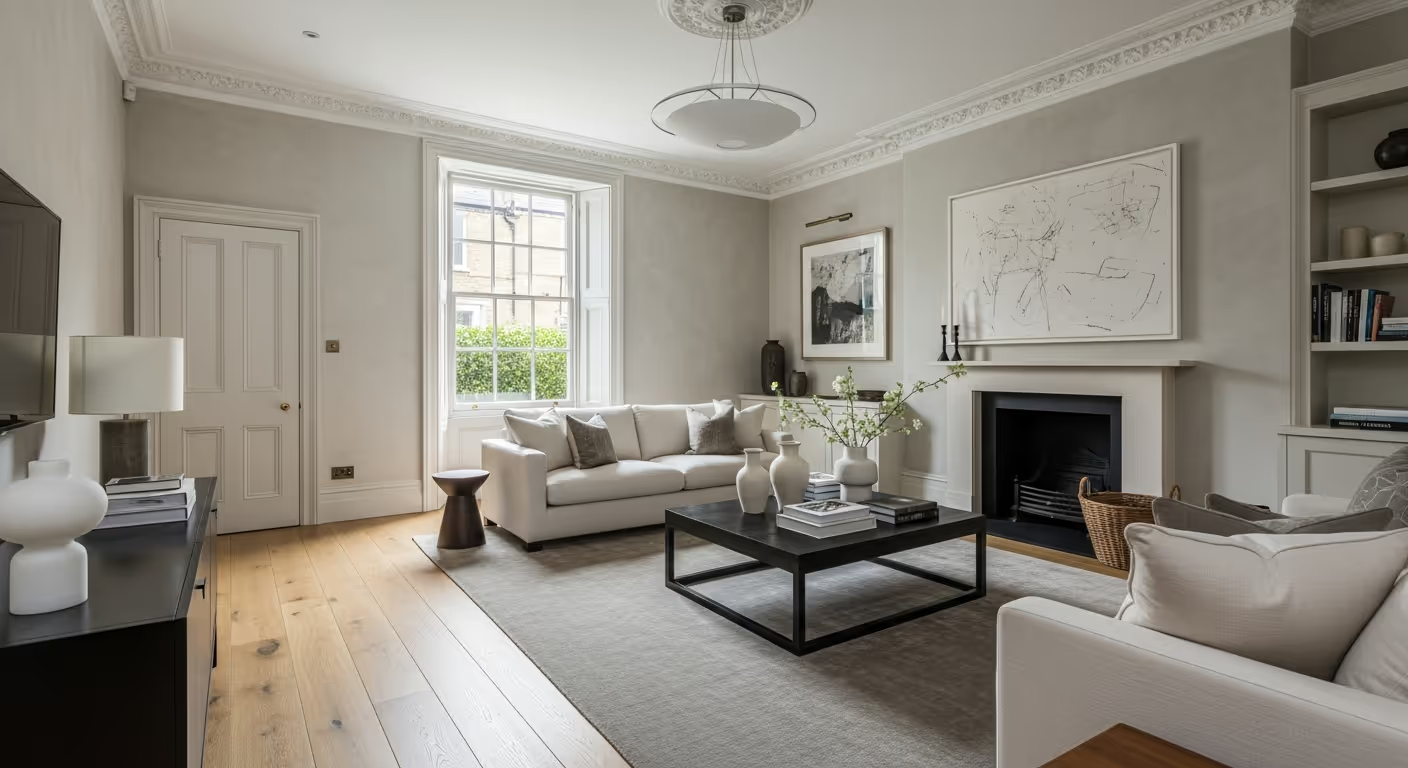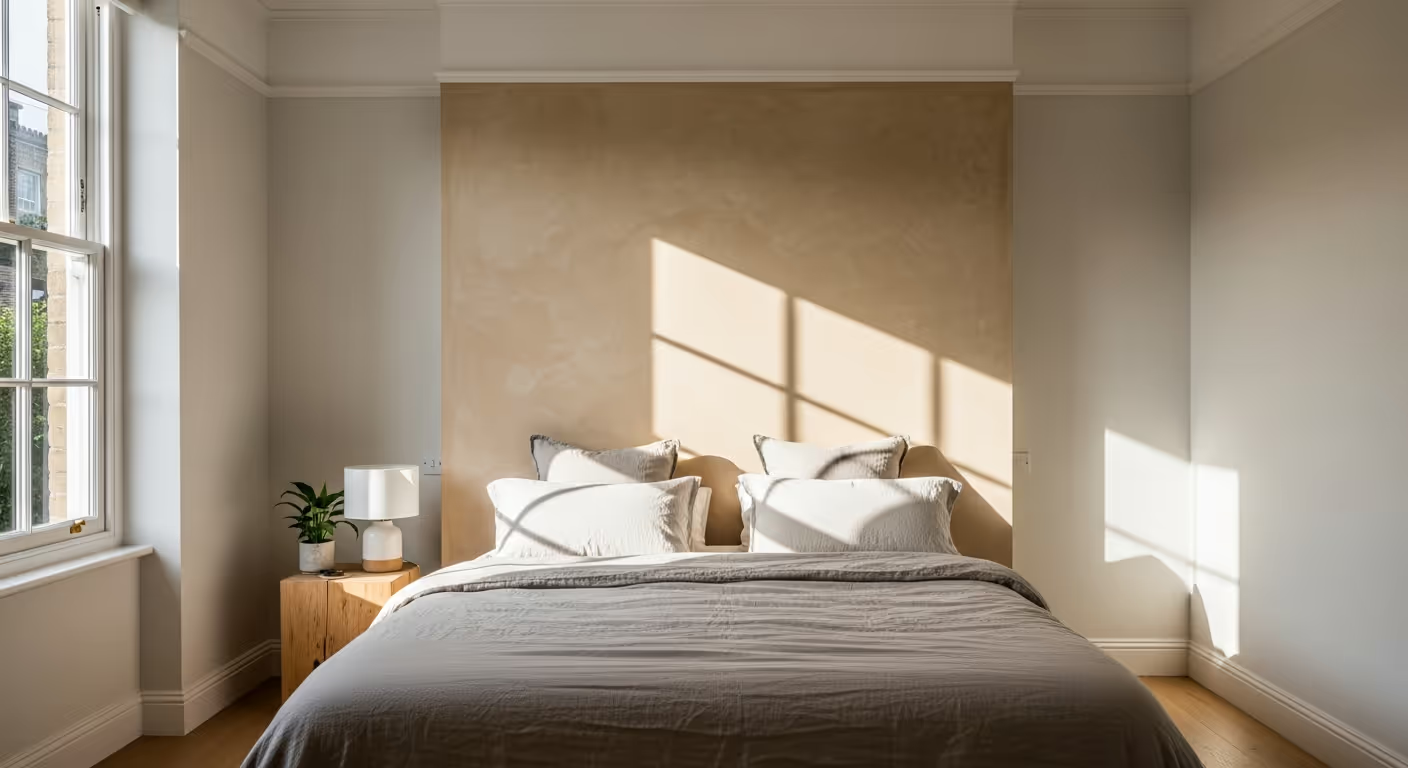
Thinking about a soft, natural look for a Kensington home. This guide explains what limewash does, how it compares to standard paint, where it works best, and how to plan the finish so rooms feel calm and refined.

Short answer: Limewash gives a natural, depth rich wall with a soft movement you cannot get from standard paint. It works best on sound mineral surfaces and in rooms where you want a calm, tactile finish. Standard paint is easier to apply and to touch up, and it suits high traffic areas or places that need frequent cleaning. Many Kensington homes use both, limewash for feature rooms and a durable paint for hallways and kitchens.
High end period homes in Kensington ask for finishes that look quiet, not flat. Limewash is popular because the wall does not look like a smooth sheet of colour. It has a gentle clouding that plays with natural light and makes plaster feel alive. Standard paint still has a clear place. It is simple to maintain, it covers fast, and it resists marks when you need a tough surface. This guide sets out how each one behaves, where to use it, and how to plan the finish so rooms feel coherent across the whole home.
Limewash is a mineral finish made with lime and natural pigments. When you brush it on a suitable base, it bonds into the surface rather than sitting on top. That bond gives a soft, matte look with a gentle movement from brush work. It is never glossy. In daylight you will see slight shifts in tone and texture that bring calm depth, which many clients love for reception rooms and bedrooms.
Because it is breathable and non film forming, it suits older buildings with solid walls. It lets moisture pass and helps the wall settle naturally. The look changes with light and with the hand that applies it. Two rooms in the same colour can feel slightly different, which is part of the charm.
Standard paint creates a uniform, predictable surface. It can be matte, eggshell, satin, or gloss, and it is available in a very wide range of shades. It is easy to specify, fast to apply, and simple to touch up. In family spaces, hallways, and kitchens, a durable paint saves time. Finger marks wipe away and scuffs are less of a concern. If you want a clean, even result with minimal care, this is a safe path. Learn more about our interior painting and decorating.
See a related case in our project: Georgian London interior.
Limewash wants a mineral friendly base. Fresh lime plaster or mineral primers are ideal. The wall should be clean, dry, and free of loose paint. If the surface has many layers of old acrylic paint, the limewash may not bond well. In that case, a suitable mineral primer can help. The key is a base that allows the lime to bind and breathe. Standard paint is more forgiving and will cover a wider range of existing finishes after sanding and priming.
Limewash is brushed in thin coats. The brush work shows as a soft movement on the wall, which is part of the effect. The final look depends on number of coats, dilution, and the hand of the decorator. Expect a natural variation from one wall to another, which is why sample panels are vital before you decide. Standard paint is usually rolled and laid off with a brush for edges. It gives a smoother, more even field with little variation.

Kensington rooms can face north, south, or west and many have tall sash windows. In north light, soft warm neutrals help the room feel alive. In south light, cooler tones stay balanced. Limewash colours tend to feel more organic since the pigment sits within a mineral base. Standard paint gives access to sharper shades and very precise matching across rooms and joinery. If you plan to combine the two, choose a colour family that works in both systems. Do a sample panel for each room and check it in morning and late afternoon light.
Limewash is a living finish. It hardens as it carbonates, which takes time. Early marks can often be blended with a careful patch, but full touch up needs a soft hand and may require feathering across a wider area. In low touch rooms this is easy. In high touch spaces it is better to plan a durable paint. Standard paint is simple to wipe and touch up. For many homes, the most practical plan is limewash in the quiet rooms and durable paint where life is busy.
One of the best layouts for a Kensington townhouse uses limewash in the drawing room, study, and main bedroom, then a durable matte or eggshell in the hallway, kitchen, and children’s rooms. Use the same colour family so the house feels consistent. Keep joinery in a soft eggshell to tie the scheme together, which lets wall texture change without breaking the flow. If you plan a bolder limewash tone in a single room, repeat a lighter tint of that tone in a nearby space so the eye reads a gentle rhythm as you move through the home.
Bathrooms and kitchens can include limewash on walls away from direct splash, but they need planning. Sealants and compatible top coats exist, yet they may change the look. If you want the pure limewash effect, keep it for dry zones and use a tough, moisture resistant paint for near the sink and shower. Good ventilation helps any finish last. In powder rooms, limewash can be very elegant since there is less steam and fewer hard marks.
A full room in limewash typically takes more time than a standard repaint. There is extra care in surface prep, sample panels, and the hand applied coats. Drying can be slower, and the finish continues to settle in the days after. If your project has a fixed deadline, book early and allow a margin. Standard paint moves faster and suits tight schedules, which is another reason many clients choose a mix of both systems.
Rather than list figures, it helps to understand the drivers. Limewash cost depends on surface condition, number of coats, and the need for mineral primers. Skilled hand work adds time. Standard paint varies with colour change, sheen, and the amount of joinery to finish. Supply of high grade brushes, rollers, and sheeting is constant for both. If you share photos and room sizes, a site visit can turn these drivers into a clear written plan that matches your home.
A sample panel shows the true colour and movement in your own light. Mobile phone swatches and printed cards cannot reproduce the depth of a mineral finish. Ask for two or three options in the same family, one slightly warmer, one slightly cooler. Live with them for a day. Check morning light, midday, and evening. Choose the one that makes the room feel calm at all times, not just for a single photo. When you are ready, you can book a sample panel visit.
Will limewash show every mark? In quiet rooms it stays beautiful and small marks blend with the movement. In heavy traffic areas it will need more care than durable paint.
Can I limewash over old paint? Only if the surface is suitable and primed the right way. A site check will confirm this.
Does limewash work with underfloor heating? Yes on stable walls. Good airflow helps even curing.
Can I use it on ceilings? Yes. It looks very calm in rooms with cornices since the soft texture sits well with plaster detail.
Drawing room: A pale warm neutral in limewash gives quiet depth that suits art and soft furnishings.
Dining room: A slightly deeper tone feels intimate without looking heavy. Candles and low light bring out the texture.
Main bedroom: Soft grey beige or a gentle clay tone brings rest. Keep trim in eggshell to frame the walls.
Hallway: Use a durable matte in a near match to the reception rooms. The house will feel consistent and you gain easy cleaning.
Kitchen: Limewash for the breakfast nook or a feature wall away from steam, durable paint for the main cook zone.
Children’s rooms: Durable wall paint for easy touch ups, with the option for a limewash feature behind the bed if you want texture without risk.
Share your rooms, photos, and the way you use each space. Say where you want the soft, natural movement and where you need a tough clean surface. Ask for sample panels in two or three tones and confirm the exact base system that suits your walls. Agree a simple plan for prep, coat count, and a tidy daily routine so the home stays liveable. In a Kensington setting, many projects run while the household stays in place, which means good protection and clear communication matter as much as the finish itself. You can see our recent projects for ideas.
We work across Prime Central London with many projects in Kensington, Chelsea, Belgravia, Notting Hill, Knightsbridge, and Westminster. If you plan a limewash scheme in one of these areas, we can visit, show sample panels, and write a room by room plan that fits your timeline.

Ready to decide between limewash and standard paint? Send a few photos of each room and say how you use the space. We will reply with a simple scheme that combines the best of both systems so your home feels calm, refined, and easy to live with. You can request a site visit to get started.
.avif)
.avif)
.avif)
You can also complete the form to send us a message, or call us on (0203) 5810807